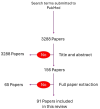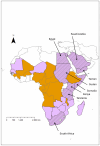The socioeconomic impacts of Rift Valley fever: A rapid review
- PMID: 39207938
- PMCID: PMC11361445
- DOI: 10.1371/journal.pntd.0012347
The socioeconomic impacts of Rift Valley fever: A rapid review
Abstract
Rift Valley fever (RVF) is a neglected vector-borne disease which is endemic in many countries across Africa and has seen recent geographical expansions into the Arabian Peninsula. RVF can cause severe infections in both animals and humans. RVF infections in livestock can lead to mass fatalities. In humans, the symptoms are nonspecific and can often lead to misdiagnosis. However, a small proportion progresses to haemorrhagic infection with a significantly higher mortality rate. The culmination of this can cause severe socioeconomic impacts. This review aims to identify the main socioeconomic impacts caused by RVF outbreaks as well as existing knowledge gaps. Ninety-three academic and grey papers were selected, covering 19 countries and 10 methodological approaches. A variety of socioeconomic impacts were found across all levels of society: Livestock trade disruptions consequently impacted local food security, local and national economies. Most livestock farmers in endemic countries are subsistence farmers and so rely on their livestock for sustenance and income. RVF outbreaks resulted in a variety of socioeconomic impacts, e.g., the inability to pay for school fees. Main barriers to vaccine uptake in communities were lack of access, funds, interest along with other social aspects. The occupational risks for women (and pregnant women) are largely unknown. To our knowledge, this is the first review on RVF to highlight the clear knowledge gap surrounding the potential gender differences on risks of RVF exposure, as well as differences on occupational health risk in pastoral communities. Further work is required to fill the gaps identified in this review and inform control policies.
Copyright: © 2024 O’Neill et al. This is an open access article distributed under the terms of the Creative Commons Attribution License, which permits unrestricted use, distribution, and reproduction in any medium, provided the original author and source are credited.
Conflict of interest statement
The authors have declared that no competing interests exist.
Figures




Similar articles
-
A Systematic Scoping Study of the Socio-Economic Impact of Rift Valley Fever: Research Gaps and Needs.Zoonoses Public Health. 2015 Aug;62(5):309-25. doi: 10.1111/zph.12153. Epub 2014 Sep 24. Zoonoses Public Health. 2015. PMID: 25256804 Review.
-
Rift Valley fever: biology and epidemiology.J Gen Virol. 2019 Aug;100(8):1187-1199. doi: 10.1099/jgv.0.001296. Epub 2019 Jul 16. J Gen Virol. 2019. PMID: 31310198 Free PMC article. Review.
-
Modelling the effects of seasonality and socioeconomic impact on the transmission of rift valley Fever virus.PLoS Negl Trop Dis. 2015 Jan 8;9(1):e3388. doi: 10.1371/journal.pntd.0003388. eCollection 2015 Jan. PLoS Negl Trop Dis. 2015. PMID: 25569474 Free PMC article.
-
Contemporary epidemiological data of Rift Valley fever virus in humans, mosquitoes and other animal species in Africa: A systematic review and meta-analysis.Vet Med Sci. 2023 Sep;9(5):2309-2328. doi: 10.1002/vms3.1238. Epub 2023 Aug 7. Vet Med Sci. 2023. PMID: 37548116 Free PMC article.
-
Potential effects of Rift Valley fever in the United States.Emerg Infect Dis. 2011 Aug;17(8):e1. doi: 10.3201/eid1708.101088. Emerg Infect Dis. 2011. PMID: 21801607 Free PMC article. Review.
Cited by
-
Effectiveness and equity of vaccination strategies against Rift Valley fever in a heterogeneous landscape.PLoS Negl Trop Dis. 2025 Jul 28;19(7):e0013346. doi: 10.1371/journal.pntd.0013346. eCollection 2025 Jul. PLoS Negl Trop Dis. 2025. PMID: 40720542 Free PMC article.
-
Seroepidemiological Reconstruction of Long-term Rift Valley Fever Virus Circulation in Nouakchott, Mauritania.J Infect Dis. 2025 Jun 2;231(5):e853-e861. doi: 10.1093/infdis/jiaf108. J Infect Dis. 2025. PMID: 40037369 Free PMC article.
-
Rift Valley Fever Outbreak Investigation Associated with a Dairy Farm Abortion Storm, Mbarara District, Western Uganda, 2023.Viruses. 2025 Jul 19;17(7):1015. doi: 10.3390/v17071015. Viruses. 2025. PMID: 40733631 Free PMC article.
References
-
- WHO. Prioritizing diseases for research and development in emergency contexts [Internet]. 2022 [cited 2022 Oct 18]. https://www.who.int/activities/prioritizing-diseases-for-research-and-de...
-
- Clark MHA, Warimwe GM, Di Nardo A, Lyons NA, Gubbins S. Systematic literature review of Rift Valley fever virus seroprevalence in livestock, wildlife and humans in Africa from 1968 to 2016. PLoS Negl Trop Dis [Internet]. 2018. Jul 23 [cited 2023 Apr 12];12(7). Available from: /pmc/articles/PMC6072204/ doi: 10.1371/journal.pntd.0006627 - DOI - PMC - PubMed
-
- Hassan-Kadle AA, Osman AM, Shair MA, Abdi OM, Yusuf AA, Ibrahim AM, et al. Rift Valley fever and Brucella spp. in ruminants, Somalia. BMC Vet Res [Internet]. 2021. Dec 1 [cited 2023 Apr 12];17(1):1–6. Available from: https://bmcvetres.biomedcentral.com/articles/10.1186/s12917-021-02980-0 - DOI - PMC - PubMed
-
- Bron GM, Strimbu K, Cecilia H, Lerch A, Moore SM, Tran Q, et al. Over 100 years of rift valley fever: A patchwork of data on pathogen spread and spillover. Pathogens [Internet]. 2021. Jun 1 [cited 2023 Mar 9];10(6):708. Available from: https://www.mdpi.com/2076-0817/10/6/708/htm - PMC - PubMed
-
- Chambaro HM, Hirose K, Sasaki M, Libanda B, Sinkala Y, Fandamu P, et al. An unusually long Rift valley fever inter-epizootic period in Zambia: Evidence for enzootic virus circulation and risk for disease outbreak. PLoS Negl Trop Dis [Internet]. 2022. [cited 2023 Apr 12];16(6). Available from: /pmc/articles/PMC9197056/ doi: 10.1371/journal.pntd.0010420 - DOI - PMC - PubMed
Publication types
MeSH terms
LinkOut - more resources
Full Text Sources
Miscellaneous

